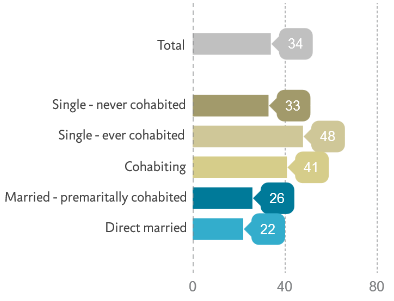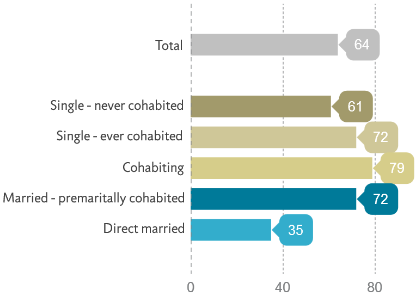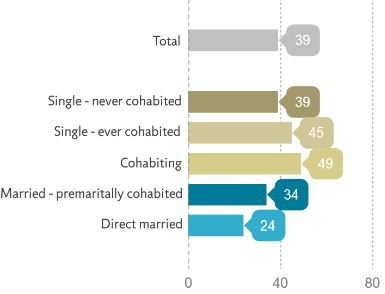Generation X and Millennials Attitudes Toward Marriage & Divorce
Family Profile No. 15, 2012
Author: Kasey J. Eickmeyer
Contemporary families have become increasingly diverse since the 1950s and 60s reflecting the rise in cohabitation, retreat from marriage, and high levels of divorce (Lichter, Sassler, and Turner, 2014; Smock, 2000). About two in five marriages end through separation or divorce (Kennedy and Ruggles, 2014). Relatively little is known about the attitudes of Americans toward marriage and divorce. This profile examines these attitudes among married and unmarried men and women aged 15-44 using the 2011-2013 National Survey of Family Growth (NSFG). Attitudes are compared by relationship status, i.e., single, never cohabited; single, ever cohabited; cohabiting; premaritally cohabited married; and direct married. Pessimism about marriage, support for cohabitation as a means to divorce-proof marriage (Smock and Manning, 2015), and for divorce as a solution to marital problems varies by relationship status. Direct married individuals have the most optimistic views about marriage and are least accepting of premarital cohabitation and divorce while those who are unmarried and have ever or are currently cohabiting are the most pessimistic about marriage and are more accepting of premarital cohabitation and divorce. Attitudes do not differ by generation or gender, with members of Generation X (born 1965-1980) and Millennials (born 1981-2000) and men and women sharing similar views toward marriage and divorce.
Pessimism About Marriage
- Nearly two in five men and women indicated that marriage has not worked out for most people they know.
- Assessments did not differ by gender or age (not shown).
- About half of singles who had ever cohabited and 41% of cohabiters expressed pessimism about marriage.
- Married men and women less often reported pessimism about marriage, with slightly higher levels of agreement among those who cohabited prior to marriage.
Figure 1. "Marriage has not worked out for most people I know."

Cohabitation to Divorce-Proof Marriage
- Over half (64%) of Gen-Xers and Millennials agreed that living together before marriage may help to prevent divorce.
- About three in five singles who have never cohabited agreed that cohabitation may divorce-proof marriage. Agreement does not differ by age or gender.
- At least seven out of ten men and women with cohabitation experience reported that cohabitation may help divorce-proof marriages.
- Only about one-third (35%) of individuals who married without cohabitation (direct married) believed that cohabitation may help prevent divorce.
Figure 2. "Living together before marriage may help prevent divorce."

Divorce Resolution for Marital Problems
- Two out of five men and women agreed that divorce was usually the best solution when a couple can’t seem to work out their marriage problems (see Figure 3).
- Gen-Xers and Millennials shared similar views (not shown). Attitudes were comparable for men and women (not shown).
- Unmarried respondents were more supportive of divorce than married. Singles who have cohabited (45%) and cohabiters (49%) were most supportive of divorce.
- Currently married expressed the lowest levels of support for divorce. One in three men and women who had cohabited prior to marriage supported divorce as did one in four direct marrieds.
Figure 3. "Divorce is usually the best solution when a couple can't seem to work out their marriage problems."

References
- Data: 2011/13 National Survey of Family Growth, Female amd Male Respondents.
- Kennedy, S. & Ruggles, S. (2014). Breaking up is hard to count: The rise of divorce in the United States, 1980-2010. Demography 51(2), 587-598.
- Lichter, D. T., Sassier, S., & Turner, R. N. (2014). Cohabitation, post-conception unions, and the rise in non marital fertility. Social Science Research, 47, 134-147.
- Smock, P. J. & Manning, W. D. (2015). New couples, new families: The cohabitation revolution in the United States. In Barbara J. Risman and Virginia Rutter (Eds.), Families as They Really Are. Second Edition. New York: Norton
- Smock, P. J. (2000). Cohabitation in the United States: An appraisal of research themes, findings, and implications. Annual Review of Sociology, 26, 1-20.
Suggested Citation
- Eickmeyer, K. J. (2015). Generation X and Millennials: Attitudes Toward Marriage & Divorce. Family Profiles, FP-15-12. National Center for Family & Marriage Research. Retrieved from: https://www.bgsu.edu/ncfmr/resources/data/family-profiles/eickmeyer-gen-x-millennials-fp-15-12

Updated: 05/21/2021 10:32AM

